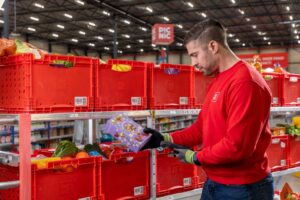The venture capital landscape in agriculture technology has changed dramatically over the last four years – funding increased from $500 million in 2012 to $4.6 billion in 2015 alone – but fundraising is still a struggle for startups, emphasized by the 30% drop in funding to agtech startups last year to $3.2 billion. Startups say it’s still a buyer’s market today; that’s squeezing them on valuations and drawing out the timeline of raising capital over several months.

But funding is definitely available for the right projects and developments, provided they hit the right areas of user need, argues Adam Anders, managing partner of Dutch agtech venture capital firm Anterra Capital. If you’re a budding innovator, however, you won’t succeed in commercializing your ideas without a great management team in place, irrespective of how good your original idea may be.
Anders was speaking to AgFunderNews after assessing 10 startups as a judge of Nutreco’s Feed Tech Challenge, which MicroSynbiotiX, the microalgae-based aquaculture vaccine tech won. Here’s more from our conversation.
How was the event?
It was a one-corporate-specific agtech event that started out with the pretty ambitious goal of finding a ‘breakthrough innovation for feeding the future that simply cannot wait.’ Even with such a goal, I think the way Nutreco approached it was successful.
One key element was that they brought a diverse group of finalists together, as is the nature of entrepreneurs, resulting in several different agtech sub-sets being addressed. They also involved a number of key internal and external specialists in the two-day final, all with the freedom to interact with the entrepreneurs throughout the process.
To top it all, they offered a prize that was effectively a ‘money can’t buy’ chance for the finalists. It wasn’t just a chance to take a product through to trial, which you could pay for, but rather an offer backed by Nutreco’s state of the art facilities, knowledge, network and commitment. That was something quite special.
When you open the door to such a broad range of possible solutions, there’s a risk you find a great product that sadly doesn’t hit your target. You tend to get what you ask for, after-all. So, did Nutreco ask the right question when they set the original challenge?
Yes, I’m confident they did, judging by the finalists we were presented with.
Clicking through the areas covered by the 10 contenders we had software development and a better way of dealing with livestock, which is going to be a fundamental aspect of the future of any animal nutrition business; a focus on alternative proteins, which is absolutely an essential ingredient in animal feed nutrition; plus the idea of pushing the agtech boundaries in terms of animal health.
That’s how I would bracket the finalists, all of whom processed elements of medium to long-term strategic significance for Nutreco as a company and for me as a venture capitalist investor in this sector.
Now, it’s also fair to say that some of the finalists more precisely hit Nutreco’s business needs for tomorrow than was the case with others. But this was an innovation challenge; not about meeting the company’s P&L demands for 2017.
In terms of presentation strengths and weaknesses, how did you rank the 10 finalists?
In almost any agtech competition, it’s common to have companies that are at different stages of development. That makes it complicated as a judge, especially how you assess something that is relatively mature and has had substantial funding versus something that is at an earlier stage, all within the same competition.
It’s difficult if you set a hard line on whether a product or idea is ready for its trial phase, ready for commercialization, or even ready for VC funding. As a judge you must step back and look at whether or not you’re studying a transformative idea that will ultimately be worth funding.
Against that background, I think the 10 Challenge finalists definitely measured up. I could certainly see why they were invited to The Netherlands. When it comes to whether or not they will be able to deliver on the promise of their presentations, however, that’s a different question.
As happens with competitions of this sort, you often have a couple of winners that look reasonably close to delivering on their promises, backed by a strong and structured plan, and a couple who have a bit more work to do.
How about the choices you as a judge, and presumably Nutreco as well, face between a great product, handled by a not so great developer, and a great developer with a not so good product?
Yes, right! You know, management is always key. Frankly, even if you have a really transformative idea or a great piece of IP, you ultimately won’t be able to commercialize it without a great management team. You always need the key attributes of getting on with the job, being able to sell, being able to raise capital, being able to communicate your idea and providing leadership.
Is there currently VC money out there for these type of products, projects, developments?
It’s very easy to say that four years ago there absolutely was not money out there. As AgFunder’s own numbers will show, I think that’s now changed. In addition, the target area which Nutreco selected for its Challenge has been under-funded in recent years compared to other parts of the value chain.
There has been a change in attitude from both sides; entrepreneurs and the big corporates. Focusing on the issues concerning animal nutrition, for example, I think we are going to see more Challenge-type successes in the future as the big corporates look increasingly towards outsourcing innovation or accepting outsourced ideas as part of their solution, than they did in the past.
I think Nutreco, for example, would say that over 90% of their commercialized ideas to date were developed in-house. That is a process that I think they realize is going to change, which is why they put on this challenge.
I also believe this process is fundamentally going to change for food and agriculture big corporates generally, with the 10 entrepreneurs who were involved in the Challenge final being perfect examples of how things are starting to change.
What do you think? Email [email protected]




